





This is an introduction to some of the most ornamental of the Australian cycads, the larger Macrozamias.
The genus Macrozamia is an exclusively Australian one, and often overlooked by those who like to collect exotic plant species or landscape their yard. Macrozamia is divided into two 'subgenera', referred to as section Macrozamia and section Parazamia. The former are the subjects of this article, while the Parazamia species (the smaller and twisted-leaf forms) will be reviewed in a later article. Some of these larger Macrozamias make fabulous potted specimens, and large imposing wonderfully symmetrical landscape plants.
Macrozamias are unique among the cycads in how they form new leaves. Nearly all the other cycads produce new leaves periodically in 'flushes' when one to dozens of new leaves erupt from the top of the caudex all at once. But most Macrozamias produce leaves either singly (especially when young) or continuously (particularly the older, larger species) one leaf at a time. Few, if any, actually produce a flush of leaves as seen in other genera of cycads. These larger Macrozamias all have thin, flat leaflets that end in a point. At the base of each leaflet where it attaches to the rachis there is a thickened yellowy tissue that is unique to Macrozamias. Some species hold many dozens of leaves at a time--far more than normally seen in other cycad species. This is one of the reasons some of these plants are so ornamental: they look like large, semi-spherical clumps of deep green plastic-like grass. Sometimes in botanical gardens they are mistaken for large Australian or Mexican grass trees (Xanthorrhoea and Dasylirion.)
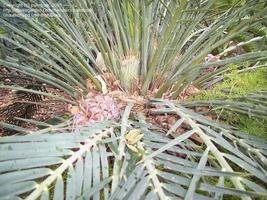 Macrozamia communis with cones and new leaves constantly being made
Macrozamia communis with cones and new leaves constantly being made
Some of the Macrozamias are fairly large plants, up to 15 feet across from leaf tip to leaf tip, and some develop large, palm-like trunks up to 20 feet tall or more (e.g. Macrozamia moorei.) Most Macrozamias have subterranean trunks (or caudeces,) though with age some eventually form a short above-ground stem.
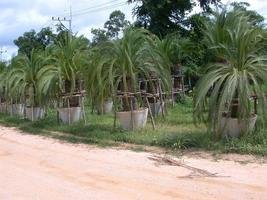
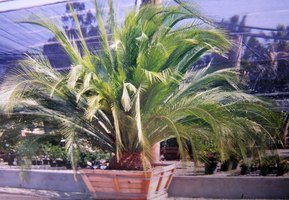
(left)Several Macrozamia moorei with 3 to 4 feet of clear trunk. (right) Macrozamia johnsonii with a caudex about 2.5 feet in diameter
As with all other cycads, plants are either male or female and never both (in other words, these are dioecious plants.) All produce deep green spiky cones. Female cones are wide, while males are thinner and taller.
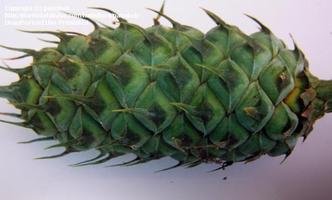
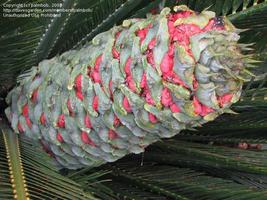
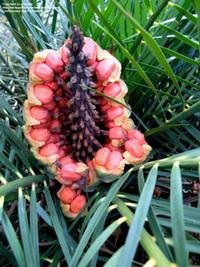
(left) Female cone (Macrozamia communis.) (middle) Macrozamia moorei cone with ripening fruit. (right) Opening cone and fruit falling out.
Most of these larger Macrozamias are full sun plants and some suffer if given much shade at all. In general these are fairly cold-hardy plants, most tolerating light frosts, and some fairly moderate freezes (though few tolerate climates in which it snows regularly.) These are about the only cycads that I have problems with mealy bugs. I assume this is partly due to the large number of closely spaced leaves, which provide little room for light and air circulation to deter these pests. Most of these cycads respond well to plenty of water and fertilizer. I have rotted a few from overhead watering in winter, so you might want to avoid that.
The following is a brief discussion of some of the more common larger Macrozamias. This will not be a complete overview as some of the species are very rare and I don't have photos of them, or know much about them.
Macrozamia communis. As the name suggests, this is a relatively common species in Australia. In some areas of New South Wales, it grows in seemingly endless fields under the Eucalyptus. Because of its commonness, many collectors of rare cycads avoid this species and I think that's too bad. It's a beautiful plant, having deep blue-green robust leaves with relatively stiff and very sharp-tipped leaflets. It gets to a be a pretty large plant, growing up to six feet tall and about ten feet wide. As a seedling it is one of the slower growing species, and takes many years to finally pick up speed to the point where it is in a state of constant new leaf production. It is very cold hardy handling frosts easily, but also performs well in hot, dry, full-sun climates (if given plenty of water.) In some areas of its Australian range, it can be dusted periodically with light snowfall with no apparent ill effects.
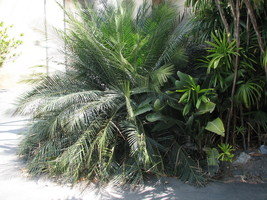
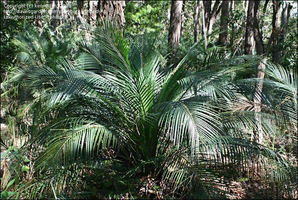
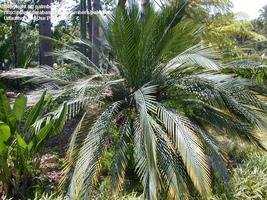
(left) Large specimen of Macrozamia moorei in California. (middle) In the wild (photo by kennedyh- thanks.) (right) Another trunking plant in botanical garden.
Macrozamia diplomera. This is the peculiar member of this group of Macrozamias. It is the smallest of the section Macrozamias and often has forked leaves (a rarity among any cycad, though a few other Macrozamias in the Parazamia have forked leaflets as well.) The leaves of mature plants tend to be bluish green. They are either oriented in an upright and shuttlecock appearance, or lax and droopy. This is an excellent, though very slow-growing, container plant; or a good landscape plant for smaller areas of the garden. This species, perhaps more than any other in this subgenus, really needs good drainage or it is prone to rot. It is quite cold hardy and can handle many degrees of frost with little trouble.
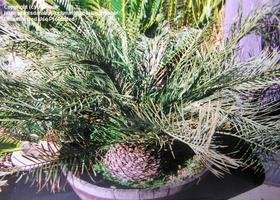
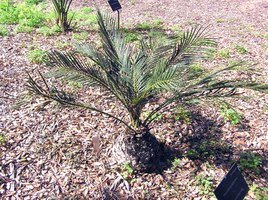
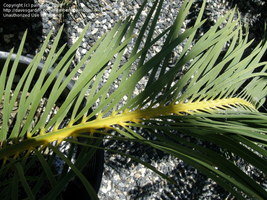
(left) Old potted specimen. (middle) Plant in botanical garden with few, if any, split leaflets. (right) Typical split leaflets
Macrozamia dyeri. There are only three Macrozamias from Western Australia and they look similar, though this is really the most attractive. This is a beautiful medium to large cycad with a perfect shuttlecock of leaves, and slightly arching blue-green stiff and very pointed leaflets. The trunks can eventually grow above ground to upwards of eight feet or more (though I have never seen one near that tall.) Leaflets are a deep blue-green, and symmetrically spaced along the leaves. My experience with this species is limited as it is fairly rare and very slow growing. When young, this plant is prone to rot if over-watered or grown in soil that is not extremely well draining.
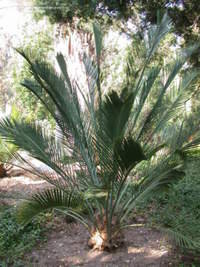
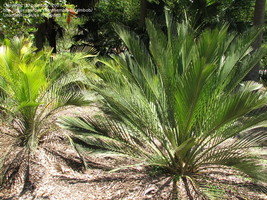
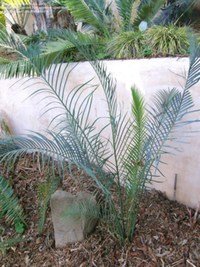
(left and middle ) Maturing Macrozamia dyeris in southern California. (right) Younger seedling in California.
Macrozamia fraseri. This is another of the Western Australian species and is nearly as rare as Macrozamia dyeri in cultivation. It is also about as large as Macrozamia dyeri, perhaps larger, but not as symmetrical, and the leaflets are more closely spaced and bright green. It really looks like a larger version of Macrozamia riedlei (see below,) the third Western Australian species. Mature plants develop an orange, wool-like substance around the base of the leaves.
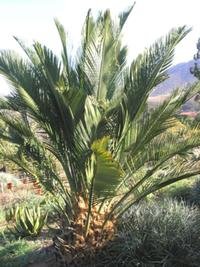
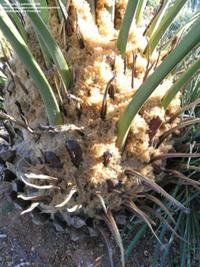 Macrozamia fraseri in California, and shot of fuzz on caudex
Macrozamia fraseri in California, and shot of fuzz on caudex
Macrozamia johnsonii. This is a massive cycad, one of the largest of all the Australian cycads and a wonderful landscape plant. Mature plants can develop trunks up to nine feet tall and over well over two feet thick. They hold up to, and sometimes over, 100 leaves at a time. The leaves are a bright green to nearly yellow-green and are straight, slightly arching and flat in cross-section (compare to Macrozamia moorei which is sometimes confused with this one, and has twisted leaves that are strongly ‘V'd in cross-section.) Leaflets are very sharp but somewhat flexible near the tips of the leaves, making it one of the less offensive large Macrozamias to brush up against (leaflets closer to the leaf bases are not so forgiving.) This is the species which I have had problems with mealy bugs on several occasions. Large plants have so many leaves so closely spaced, that lack of light and poor air circulation near the crowns are not good deterrents to these creatures.
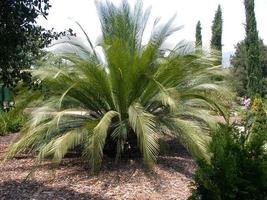
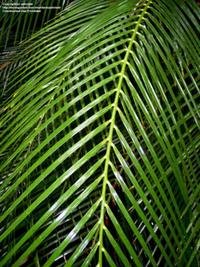
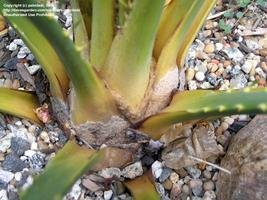
Macrozamia johnsonii in botanical garden, and close of leaf showing flat plane; Leaf bases of younger plant showing fuzz and yellow color
Macrozamia longispina. Probably my favorite of this group of Macrozamias, this is a medium sized species with thin, very long and flexible bright green leaflets. It is one of the most elegant-looking of the Macrozamias and certainly worthy of both pot cultivation and landscape use. Currently still quite rare, it is becoming more common in cultivation. It may not be the most frost tolerant of the Macrozamias, but I don't think it has been well tested yet. It can be hard to tell from Macrozamia miquelii and M. mountperriensis, though it has even longer leaflets and more upright leaves.
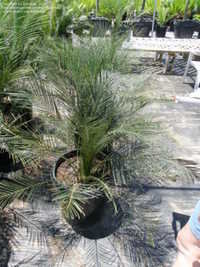
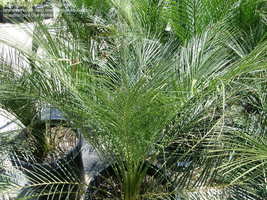 Macrozamia longispina for sale
Macrozamia longispina for sale
Macrozamia lucida. This is one of the smaller Macrozamias of this group and has an arching, relatively sparse crown of leaves made up relatively wide, slightly falcate leaflets. It is a slow growing plant and needs some protection from hot, dry sun. Plants do not tend to hold large numbers of leaves and therefore it is not one of the most ornamental of the larger Macrozamias.

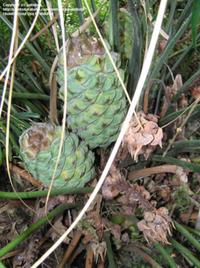
(left) Macrozamia lucida in private garden, southern California. (right) Female cones.
Macrozamia macdonnellii. Of all the larger Macrozamias, this is easily the most sought-after and probably the hardest to grow. It is a beautiful medium to large species with bluish, turquoise leaves in full sun (shade grown plants tend to be a bit less spectacularly colored, and less healthy, too.) Leaves are relatively straight and stiff, and the leaflets are very stiff and sharp making it one of the most treacherous of the larger Macrozamias to prune. This species is the most well adapted of the Macrozamias to hot, dry deserts and is very hard to grow in humid climates (though I have seen some pretty nice looking specimens in the University gardens on Hilo, Hawaii.) It is very cold-tolerant, and of course, extremely heat-tolerant. It is a difficult cycad to move, so be sure to plant it where you want it forever (plants often sulk and even die if disturbed.) It is a very pricey and rare species and over-collected in the wild; it is one of the few Macrozamias on the vulnerable list.
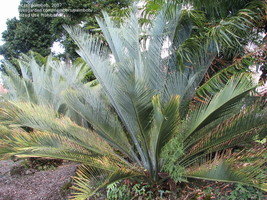
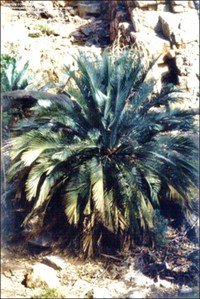
(left) Macrozamia macdonnelii in Hawaii. (right) In its habitat (photo by kennedyh- thanks!)
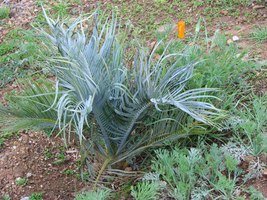
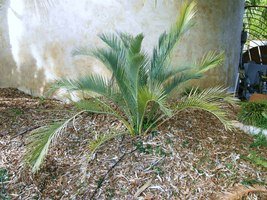
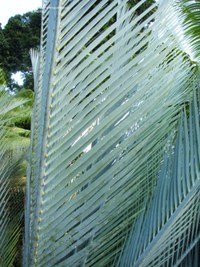
(left and middle) Macrozamia macdonnelii in California. (right) Close-up of leaf of fairly mature plant
Macrozamia miquelii. This is a medium-sized plant and fairly common in cultivation (and very common in Australia, too.) It is one of four or five Macrozamias that I have a hard time telling apart (Macrozamias douglasii, macleayi, mountperriensis and even longispinna look a lot like this one.) It forms a graceful mound of relatively soft bright green arching leaves and long, thin pointed leaflets.
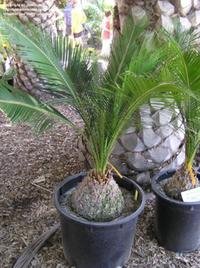
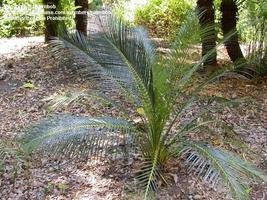 Macrozamia miquelii
Macrozamia miquelii
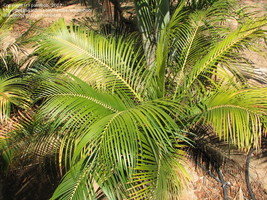
 Macrozamia macleayi and M. douglasii
Macrozamia macleayi and M. douglasii
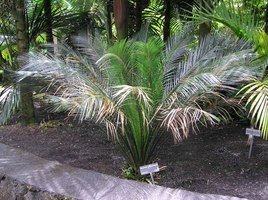
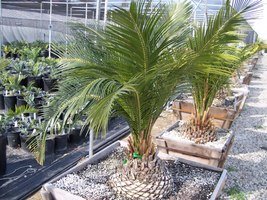 and another similar species, Macrozamia mountperriensis
and another similar species, Macrozamia mountperriensis
Macrozamia montana. This is a smaller to nearly medium sized plant with upright leaves that looks a lot like a smaller version of Macrozamia communis. It is not very common in cultivation, but I have a seedling in the garden that is pretty happy (but slow growing) in full sun. I don't know its cold hardiness but it's from mountainous areas of New South Wales so it might have some excellent ability to withstand frosts.
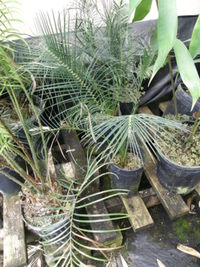
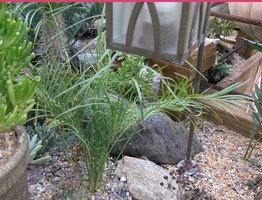 Macrozamia montana seedlings
Macrozamia montana seedlings
Macrozamia moorei. This is the classic large Macrozamia and probably the tallest of all the Macrozamias (well over 20 feet in nature.) It is a beautiful dark green to blue green plant, with strongly arching leaves and leaflets oriented in a pronounced ‘V' off the rachis. Large plants look a lot like Date Palms and hold up to and over 100 palm-like leaves. I have several seedlings in the yard and they are annoyingly slow, though picking up speed with age. This is also a very common Macrozamia and just about any place selling Cycads will have this one for sale. Larger plants are often moved about and this species tolerates this remarkably well.
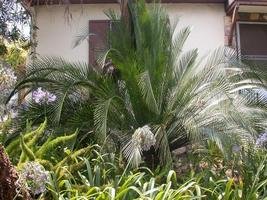
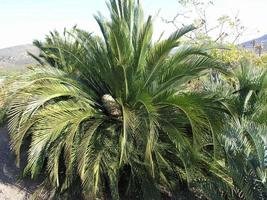
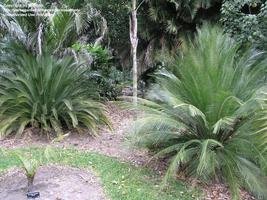
(left) Maturing Macrozamia moorei in southern California. (middle) Macrozamia moorei. (right) Macrozamia johnsonii.
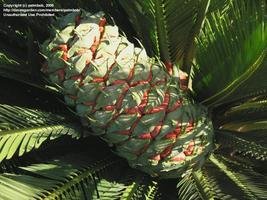
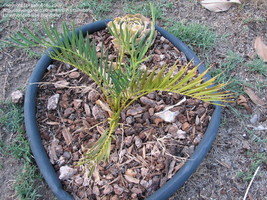
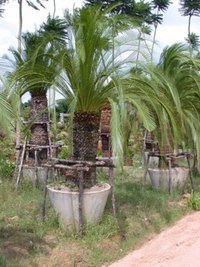
(left) Macrozamia moorei cone. (middle) Seedling. (right) Mature old plants waiting for spot to be planted in Thailand.
Macrozamia riedlei. This is the most common and easiest to grow of the Western Australian macrozamias. This one rarely forms a trunk and is a bit smaller than the other two species, with lighter green and softer leaves. Macrozamia riedlei is one of the better large Macrozamias to plant along pathways, or planter edges without causing pain or danger to passersby. This is a relatively fast and easy to grow plant, but I have rotted this one before from overhead watering in winter.
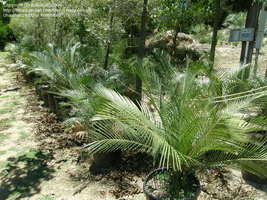
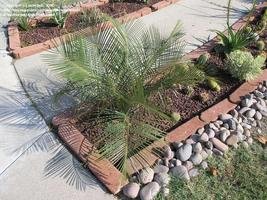
(left) Macrozamia riedlei for sale in southern California nursery. (right) My own seedling.
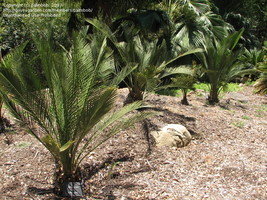
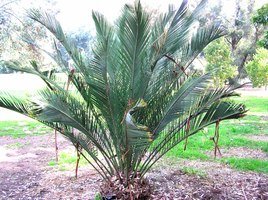 Maturing plants in botanical gardens.
Maturing plants in botanical gardens.
Macrozamia spiralis. I am not sure why this species is named, spiralis as its leaves are hardly if ever spiral... and there are plenty of other Macrozamias for which this would be a much more apt name. It is a constant source of confusion for those getting involved with this genus. This is one of the smaller cycads in this group and rarely has an above-ground stem. It is only about two feet tall and is a spreading plant with relatively soft arching leaves, usually only 10 to 12 per plant. It grows in some of the harshest rocky Eucalypt environments of any of the larger Macrozamias in New South Wales where it rarely gets super hot, but often goes down to freezing. In these areas it is a very common plant, and it has become a conventional one in cultivation as well, though perhaps not one of the more popular. It is rather non-ornamental compared to most of the other larger Macrozamias. Macrozamia elegans is a rarer but very similar species.
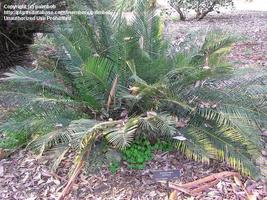 Macrozamia spiralis in botanical garden (note the lack of spiraling leaves.)
Macrozamia spiralis in botanical garden (note the lack of spiraling leaves.)
Copyright © www.100flowers.win Botanic Garden All Rights Reserved